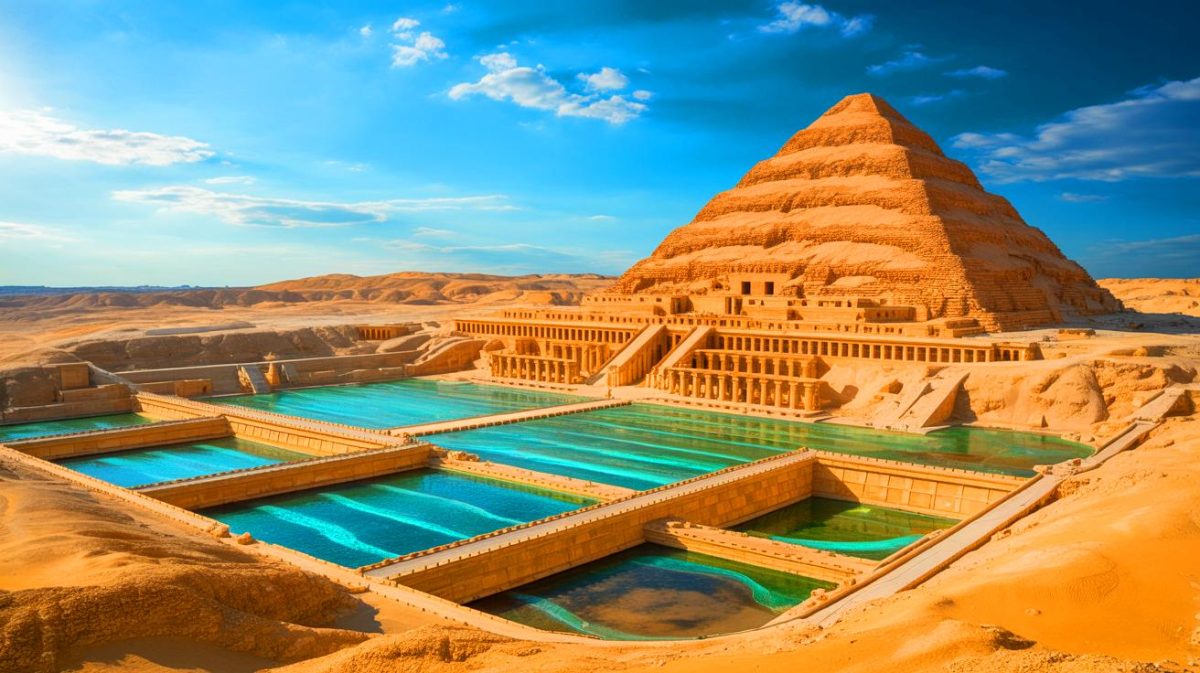| IN A NUTSHELL |
|
Recent archaeological findings in Egypt have unveiled a groundbreaking understanding of ancient engineering techniques, particularly around the iconic Pyramid of Djoser. Researchers have discovered a sophisticated water management system that challenges previous notions of ancient Egyptian technological capabilities. This complex network, which includes dams, basins, and shafts, demonstrates a remarkable level of hydraulic engineering that historians are just beginning to fully comprehend. The significance of these findings is profound, prompting a reevaluation of ancient Egypt’s engineering prowess and inviting speculation about other potential technological wonders that have yet to be discovered.
Ingenious Stone Dam Capturing Desert Floodwaters
The Gisr el-Mudir structure, traditionally shrouded in mystery due to its massive scale and ambiguous purpose, has recently been reinterpreted as a highly advanced stone dam. This ancient construction was designed to capture and store seasonal floodwaters in the arid Egyptian desert. Spanning approximately 1,180 feet, Gisr el-Mudir collected water from surrounding wadis, effectively transforming the landscape into a reservoir capable of supporting substantial construction activities.
By examining the area’s natural topography, researchers identified a watershed capable of channeling vast amounts of water into this enclosure. The dam’s capacity, estimated to hold up to 14 million cubic feet of water, highlights its strategic importance. This discovery suggests that the location of Saqqara, home to the Pyramid of Djoser, was selected not only for its religious significance but also for its advantageous geological features, providing a dependable water source essential for monumental building projects.
How Hydraulic Construction of Pyramids Worked
The availability of a significant water supply was critical for pyramid construction, but it was the innovative use of hydraulic systems that truly defined these architectural feats. Beneath the Djoser complex lies an extensive network known as the “Deep Trench,” initially thought to be purely symbolic. This system of basins and compartments likely served as a water treatment facility, purifying water for a vertical lifting mechanism.
Researchers propose that this mechanism functioned much like a hydraulic elevator. By harnessing water pressure, stone blocks placed on a floating platform could be elevated with remarkable efficiency. Once raised, these blocks could be maneuvered onto the pyramid’s higher levels with minimal physical effort. This groundbreaking method underscores the ancient Egyptians’ mastery in utilizing natural forces to achieve architectural marvels that continue to captivate modern engineers.
Sophisticated Technology Matching Pharaohs’ Ambitions
The evidence of hydraulic construction techniques at the Pyramid of Djoser challenges long-standing narratives about ancient Egyptian engineering. The integration of dams, basins, and shafts into a cohesive hydraulic system reveals a sophisticated grasp of water management that predates many modern technologies. This finding necessitates a reassessment of other Old Kingdom monuments and suggests that the Pyramid of Djoser epitomizes an advanced tradition of engineering.
Beyond their monumental architecture, ancient Egyptians excelled in irrigation and water management. Their ability to construct intricate hydraulic systems with limited resources highlights a level of innovation and resourcefulness that demands further exploration. The discoveries at Saqqara may reshape our understanding of pyramid construction, emphasizing a combination of ingenuity and adaptation that enabled the creation of these enduring structures.
How Saqqara’s Hydraulic Remains Alter Our Historical Perspective
The revelation of Saqqara’s hydraulic system opens new opportunities for archaeological exploration, shifting the narrative from purely symbolic interpretations of pyramids to their technical and environmental contexts. The architects of these ancient structures were not merely fulfilling religious projects but were also developing sustainable ecosystems that effectively utilized available resources.
This multidisciplinary approach, which merges archaeology, hydrology, and engineering, enriches our comprehension of ancient Egypt’s history. It reveals a society capable of sophisticated work organization and material management, challenging the simplistic perception of pyramids as mere results of labor mobilization. As researchers continue to uncover evidence of forgotten hydraulic systems, we are encouraged to reevaluate other monumental sites and consider the technical genius that may lie beneath the surface.
With each archaeological breakthrough, we are reminded of the potential for future discoveries to reshape our understanding of ancient civilizations. What other hidden technological marvels await beneath the sands of time, poised to rewrite history once more?
Did you like it? 4.7/5 (28)





Wow, who knew the pyramids had such advanced engineering? 🤯
Isn’t it amazing how much we still have to learn from ancient civilizations?
Are there any other pyramids with similar hydraulic systems?
This is mind-blowing! The ancient Egyptians were true geniuses. 💡
So does this mean aliens didn’t help build the pyramids? 😂